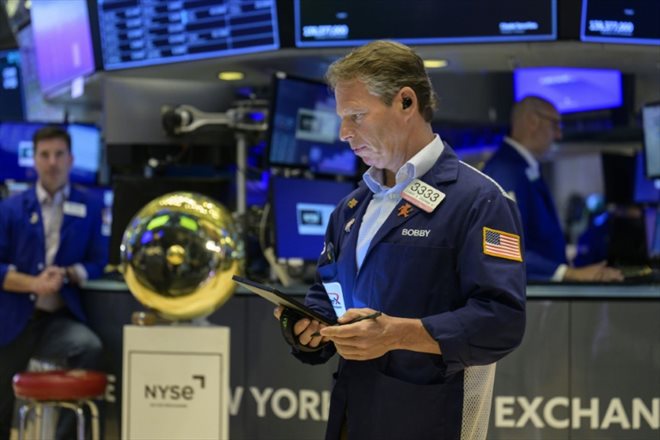The floor of the New York Stock Exchange (AFP/ANGELA WEISS)
The New York Stock Exchange ended down on Wednesday, seizing the lowering of the United States’ rating by the Fitch agency as an excuse for a break, in a market that never stopped rising.
The Dow Jones returned 0.98%, the Nasdaq index slid 2.17% and the broader S&P 500 index fell 1.38%.
The Dow Jones remained on 16 positive sessions in 17 trading days.
“It was time for a correction for the market”, commented Quincy Krosby, of LPL Financial and “the Fitch report was the trigger for this reversal”.
The financial rating agency on Tuesday downgraded the United States’ rating by one notch from AAA, the highest, to AA+.
A decision justified, according to Fitch, by the repeated political crises around the budget and the debt, and concerns about the acceleration of public spending.
The New York market was somewhat tense, the VIX index, which measures the nervousness of operators, rising to its highest level in a month, even if it remains low on average historical.
Sign that this announcement was, for Wall Street, an excuse for a consolidation more than a shock, the bond market reacted calmly.
The yield on 10-year US government bonds rose only slightly, to 4.07%, against 4.04% the day before closing.
“What Fitch said is important, (…) but Moody’s has not followed, for the moment, when they have a greater weight on the market”, argued Quincy Krosby to explain the low reaction of investors, while an equivalent decision by the agency Standard and Poor’s, in August 2011, had caused an earthquake.
Moody’s, the third major agency with S&P and Fitch, thus still grants the United States its maximum rating, ie Aaa, with a stable outlook, which means that it does not envisage a reduction in the short term.
The New York Stock Exchange did not find comfort in the ADP report, which nevertheless showed that 324,000 jobs had been created in July in the private sector, almost double the 190,000 positions expected by economists.
“Wall Street tends to ignore the ADP report, let alone because its new (counting) methodology is only a year old,” Edward Moya of Oanda said in a note about a report. indicator traditionally considered unreliable.
The reduced appetite for risk triggered by Fitch’s announcement and the small rise in rates worked against equities, in particular the giant capitalizations of the technology sector.
The darling of artificial intelligence (AI), Nvidia, slipped (-4.81%), as did Microsoft (-2.63%), Meta (-2.60%) or Amazon (-2 .64%), which publishes its results Thursday, after the stock market, just like Apple (-1.55%).
On the Dow Jones side, a few so-called defensive values, that is to say less sensitive to the economic situation, shone, such as Johnson & Johnson (+0.65%) or Coca-Cola (+0.36%).
Starbucks also did well (+0.86%), despite lower-than-expected revenues in the second quarter. While the international business recorded significant growth, the average amount per order marked time, even falling in China.
Elsewhere on the stock market, semiconductor maker AMD fell (-7.02%) despite better-than-consensus results and cautiously optimistic forecasts.
Investors judged that these figures were not sufficient to justify the valuation of the title, which has doubled since October.
The Italian car manufacturer Ferrari (-1.28%), listed in New York, did not benefit from better than expected quarterly results and the raising of its forecasts for the year. The new earnings projection is, however, only an alignment with those of the analysts.
The Israeli laboratory Teva, listed on Wall Street, jumped (+ 11.58%) after reporting a turnover higher than projected by the New York market, in particular thanks to its treatment against the disease of Huntington, a degenerative neurological condition.
© 2023 AFP
Did you like this article ? Share it with your friends with the buttons below.




